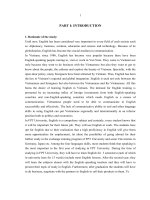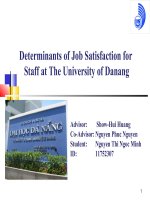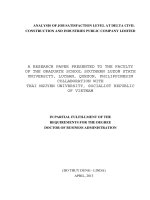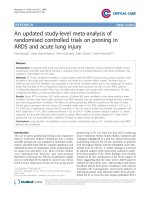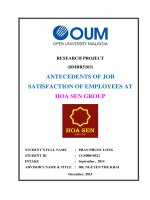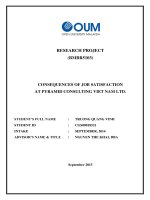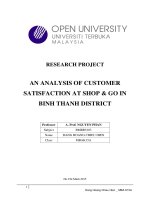ANALYSIS OF JOB SATISFACTION LEVEL AT DELTA CIVIL CONSTRUCTION AND INDUSTRIES PUBLIC COMPANY LIMITED
Bạn đang xem bản rút gọn của tài liệu. Xem và tải ngay bản đầy đủ của tài liệu tại đây (456.61 KB, 30 trang )
ANALYSIS OF JOB SATISFACTION LEVEL AT DELTA CIVIL
CONSTRUCTION AND INDUSTRIES PUBLIC COMPANY LIMITED
A RESEARCH PAPER PRESENTED TO THE FACULTY
OF THE GRADUATE SCHOOL SOUTHERN LUZON STATE
UNIVERSITY, LUCBAN, QUEZON, PHILIPPINESIN
COLLABORATION WITH
THAI NGUYEN UNIVERSITY, SOCIALIST REPUBLIC
OF VIETNAM
IN PARTIAL FULFILLMENT OF THE
REQUIREMENTS FOR THE DEGREE
DOCTOR OF BUSINESS ADMINISTRATION
(DO THUY DUNG - LINDA)
APRIL, 2013
INTRODUCTION
The researcher has aimed to study different factors behind job
satisfaction and use Delta Civil Construction & Industries Public Company
Limited (DCI) as a case study. The company is facing a problem about high
turnover of employee
1
. This has led to the management’s concern on labor
productivity as it takes sometime for the company to train these workers to
achieve their expected level of performance on the job. The causes for labor
turnover may result from many reasons both from employees themselves and
the organization. From organizational perspective, employee turnover can
represent a significant cost in terms of lost recruiting, training, socialization
investments, disruption and replacement costs, and a variety of indirect costs.
1.1. Objectives of the Research Study
The major objective of the study is to find out different factors behind
job satisfaction of employees in Delta Civil Construction & Industries Public
Co., Ltd. The following specific objectives will be considered:
♦ To study employees’ job satisfaction level in the company.
♦ To study the different factors that affect to job satisfaction of
employees in the company.
♦ To give some useful recommendations to improve employee’s
satisfaction in the company.
♦ Scope of the Research Study
The study focuses on studying different factors that have impact on
employee's job satisfaction level. The main focus of the present study is
managerial practice for Human Resource Management.
1.2. Methodology for the Research Study
1.2.1. Primary data
This research study conducts a questionnaire survey to obtain the
primary data.
1.2.2. Secondary data:
The information has been extracted from the sources such as previous
research, newspaper, magazines, journals and internet.
1.3. The Expected Contributions of the Research Study
This study is expected to contribute the following:
♦ Knowledge and understanding of the factors, which affect the
employee's job satisfaction level of the company,
♦ An understanding of a priority of the significant factors which affect
employee's job satisfaction level of the company, and
♦ Knowledge of employee's job satisfaction and result of the research
study can be used in the continuous improvement process of management,
especially in Human Resource Management, in order to reduce the employee
turnover rate and other outputs, which may be caused from employee's
satisfaction
Organization of the Research Study
Chapter1: Introduction
Chapter2: LiteratureReview
Chapter3: ResearchMethodology
Chapter4: FindingandDataAnalysis
Chapter5: ConclusionandRecommendation
Chappter 2: LITERATURE REVIEW
Chapter 2 brings some definitions about levels of job satisfaction and
factors affecting levels of job satisfaction and defines six factors affecting job
satisfaction of labors in companies including: nature of work, salary,
colleagues, leaders, training and promotion opportunities and working
environment. This chapter presents resuts of some previous research in and
out of country; builds research model and give hypothesis of research model.
There are six hypothesis correlating with six factors affecting job satisfaction
of labors in companies.
Research model
Research model is built based on theory basic of job satisfaction.
Research results of some authors in and out of country define factors affecting
job satisfaction of labors according to individual characteristics.
Individual characteristics are considered including: age, gender, learning
status, number of working year, departments.
Research model and hypothesis are presented in graph 2.1:
Graph 2.1: Research model
Nature of work
Salary
Colleagues
Levels of job
satisfaction
Leaders
Training and
promotion opportunities
Working environment
HYPOTHESIS FOR RESEARCH MODEL
Hypothesis for research model are built based on evaluating factors
affecting job satisfaction of labors in companies. In the model of this
research, there are six elements affecting job satisfaction of labors in
companies including: nature of work, salary, colleagues, leaders, training and
promotion opportunities, working environment.
Hypothesis for research models are supposed as following:
H1: Whether nature of work is well evaluated or not correlate the same
direction with levels of job satisfaction of labors .
H2: Whether salary policy is well evaluated or not correlate the same
direction with job satisfaction of labors.
H3: Whether colleagues relationship is well evaluated or not correlate
the same direction with levels of job satisfaction of labors.
H4: Whether relationship with leaders is well evaluated or not correlate
the same direction with levels of job satisfaction of labors.
H5: Whether training and promotion opporturnities are well evaluated
or not correlate the same direction with levels of job satisfaction of labors.
H6: Whether working environment is well evaluated or not correlate the
same direction with levels of job satisfaction of labors.
CHAPTER3:RESEARCHMETHODS
This chapter will present research methods which are carried out to build
and evaluate scale of measuring research concepts and check previous theory
sample, including:
(1)
Research design.
(2)
Official research: designing scale for question table, expression and
coded scale, sample design.
3.1.1.
Research process
Research process is carried out step by step as following: firstly, defining
researching aims, after that giving research model, giving simple
measurement scales, carrying out qualitative research by deep interviewing
technology (n=5), from that providing model nd correction scale, the next
step is carrying out quantitative research ( selecting samples, surveying by
question table with N=198). The next step is collected data processing in order to
test scales and data analysis based on results Crobach’s Alpha, element
anaylysis, multivariable regression analysis…The last step is discussing results
and providing solutions.
Graph 3.1: Research process
Researching aims
Research model
Selecting esuarement
scales
Qualitative research
Quantitative research
Model and adjusting
scales
Testing measurement
scales, data analysis
Conclusion
3.2.
Official research
3.2.1.
Designing by questions
All observing variables in parts also use measurement scales Likert 5
levels with the first choice means “totally disagree with the statement” and the
the fifth choice means “ totally agree with the statement”. The contents of
observing variables in parts are adjusted so as to fit with characteristics in Delta
Civil Construction and Industries Public Company Limited
3.2.2.
Expression and coding scales
As presented in the chapter 3, researching model has six factors affecting
job satisfaction of labors in Delta Civil Construction and Industries Public
Company Limited
(1)
Work
(2)
Salary
(3)
Colleagues
(4)
Leaders
(5)
Training and promotion opportunities
(6)
Working environment
CHAPTER4:RESULTSOFRESEARCH
This chapter presents the results of analysis including: (1) description of
obtained dat;
(2) Evaluate the reliability of the scale, (3) factors analysis and research model
calibration , (4) multivariable regression analysis, (5) Verification of model
assumptions.
4.1.
Collected data
Total number of delivered questionnaires is 190 of 198 employees who
currently work in the company until 31
st
, August, 2008 (due to the time of the
survey , there are some people who are in business, not available in the
company).
Total number of collected questionnaires is 178.
After testing , there are unacceptable 12 tables which are excluded ( mainly
because of lack of answering information)
Thus, the total of questionnaire tables for analyzing and processing is 166
questionaire tables with full answers choices.
Data Structure:
4.2.
FACTORS ANALYSIS
4.2.1.
Results of factors analysis
Factor analysis is used only when the coefficient KMO (Kaiser-Meyer-
Olkin) has the value of 0.5 or higher (Othman & Owen, 2000), the variable ratio
transmission (factor loading) is fewer than 0.4 will be suitable. Eigenvalue stop
(variance represents the award explained by each factor) is greater than 1 and the
total variance extracted (Cumulative Extraction Sums of Squared Loadings%)
greater than 50% (Gerbing & Anderson, 1988).
4.2.2.
Regression analysis
The analysis is done by the Enter method. The variables are taken at the
same time to select based on the selection criteria variables significant at <0.05
level. Results of regression analysis as follows:
Factors
Names of variables
1 2 3 4
colleague 3
.916
184
colleague 4
.889
colleague 1
.718
.157
Leaders 4
.611
.298 155
colleague 2
.587
.171
leader 2
.905
154
leader 1
.736
175
promotion 4
.566
.233
promotion 1
.502
.134 .285
leader 3 .362
.495
promotion 3
.401
.124 .231
salary 3
.903
salary1 101
.879
salary 4 .134
.743
salary 2
.574
work 1
.776
work 2 .194 .103
.607
Work 4 .212 129 125
.566
work 3
.511
Coefficient Cronbach’s Alpha 0.881 0.840 0.827 0.725
Initial Eigenvalues % of variance 6.822 2.612 1.508 1.223
35.906 13.748 7.935 6.435
Table 4.14: Model summary of method Enter.
Changeable statistic
Model R
R
2
R
2
adjustment
Standard
variable of
estimation
R
2
changr
r
đổi
F thay
đổi
df1
df2 Signific
ance . F
change
Coeffici
ent
Durbin-
Watson
1 .626 .392
.377
.60088 .392 25.947 4 16 .000 1.872
a. Prediction: (constant), work, salry, collegues, leaders
b. Dependent variable: satisfying
Table 4.15: The regression results using the method Enter.
Standard
coefficient
Non-
standar
Statistics
multicollinearity
Mô hình
B
Độ lệch
chuẩn
Beta
t
Mức ý
nghĩa.
Tolera
n ce
(VIF)
(constant) 3.523 .047 75.532 .000 Magnification
factor variance
colleague .181 .067 .227 2.699 .008 .535 1.870
leade
r
.181 .077 .223 2.338 .021 .414 2.418
salary .257 .058 .320 4.445 .000 .730 1.369
1
j
ob .035 .083 .041 .417 .677 .389 2.571
a. Inde
p
endent variables: satisf
y
in
g
I have adjusted R2 = 0377. However, with the results we found that the
variable "work" is not statistically significant (significance level due.> 0.05) in
the variables should be excluded from the model. The regression results after the
variable type as follows: Bảng 4.17: Model summary of using method Enter
after removing variables.
Changeable statistic
Mode
l
R
R
2
R
2
hiệchỉnh
Standar
d error
of
estimati
on
R
2
change
đổi
F thay
đổi
df1 df2
Significan
ce.
Fchange
Durbin-
Watson
1
.626
a
.391
.380
.59935 .391 34.715 3 162 .000 1.878
a. Prediction: (constant), salary, colleague, leader
b. Independent variables: satisfying
Tabled 4.16: Results of using the method Enter after removing variables.
Non- standard
ecoficient
Standard
ecoficient
Statistics
multicollinearity
Mô hình
B
Độ
lệch
chuẩn
Beta
t
Signific
anvce.
Toleran
ce
Nhân tử
phóng đại
phương sai
(VIF)
(constant) 3.523 .047 75.725 .000
colleague .188 .065 .235 2.886 .004 .566 1.766
leader .197 .068 .243 2.916 .004 .542 1.845
1
salary .268 .052 .332 5.124 .000 .893 1.120
a. Dependent: satisfying
Remaining regression model variables reached significance 3 0.05 (with
significance level <0.05) in which the variables are colleagues, leadership and
salary. The correction coefficient R2 by 0.380 which means about 38% of the
satisfaction variance explained by three independent variables: co-workers,
leaders and wages. In these variables no multicollinearity phenomenon (due to
all the VIF values of these variables are less than 2).
The regression equation showing the relationship between the level of job
satisfaction factors with colleagues, leadership, salaries are expressed through
the following equation:
Job satisfaction = 3.523 + 0.188 * colleagues + 0.197* leaders + 0.268* salary
The regression results show that only 3 of the 4 elements of the model that
affect the level of job satisfaction of employees at JSC Manufacturing
Engineering Long An is: colleagues, leaders , salary. In which sectors "salary"
means the most important for satisfaction level of employees in work (the largest
coefficient), followed by the last leader and colleague.
4.3.
Testing hypothesis
Based on results of regression analysis will explain and test given
hypothesis.
After using regression analysis, we have concluded to test the hypothesis of
the research model (as adjusted) as follows:
No No GT Contents Results
1 H1 Whether the nature of work is well evaluated or not
correlate the same direction with job satisfaction of
labors
Unacceptable
2 H2 Whether the salary policy is well evaluated or not
correlate the same direction with job satisfaction of
labors
Acceptable
P=0.000
3 H3 Whether the relationship with colleagues is well
evaluated or not correlate the same direction with job
satisfaction of labors
Acceptable
P=0.004
4 H4 Whether the relationship with leaders is well evaluated
or not correlate the same direction with job satisfaction
of labors
Acceptable
P=0.004
4.4.
Inspection of the difference in the lwvels of satisfaction according to
individual charasteristics
In this section, we will carry out to examine which differences each
individual factor affecting the level of job satisfaction of employees in Delta
Civil Construction and Industries Public Company Limited Testing gender
differences toward job satisfaction of labors in Delta Civil Construction and
Industries Public Company Limited.
Because surveyed genders have two variables: women and men, using
Independent t-test to draw a conclusion whether women or men have higher
levels of job satisfaction.
Table 4.17: Results of Independent t-test Statistics according
to groups of genders
Giới
tính
N Average
Statistical
error
Average
standard
deviation
1 163
3.5307
.76567 .05997 satisfaction
2 3
3.0833
.14434 .08333
Table 4.18: Results of Independent t-test compare levels of job satisfaction
according to genders.
Testing
equality of
variance
Reliability 95%
Level
of
signific
ance
Level of
significa
nce
average
differen
ce
Standard
deviatio
n
differen
ce
The
assumption
of equal
variances
3.551
.061
1.009 164 .315 .44734 .44348 42832 1.32300
Satisfying
The
assumption
of unequal
variances
4.357 4.593
.009
.44734 .10267 .17623 .71846
Based on the value average of men higher than average of women (Table
4.19) the boolean men you dumpdir satisfied Man in the job cao higher than
women.
4.1.1 Testing the impact of different levels of age toward job satisfaction of
employees in Delta Civil Construction and Industries Public Company Limited.
Because“age”intheresearchhas4variables,weuseOne‐WayANOVAtest.
Table 4.19: One-Way ANOVA Results compare levels of job satisfaction
according to the age.
Total
square
df
Average
square
F
Levels of
significance.
Among groups .471 3 .157 .267 .849
In the same group 95.132 162 .587
Total 95.603 165
Table 4.21 shows that between the groups with significance level = 0849 (>
0:05), so we conclude there is no difference between age groups in the
satisfaction level of the employees work in Long An Engineering and
Manufacturing Joint Stock Company.
Testing differences in “ qualifications” toward job satisfaction of
employees in Delta Civil Construction and Industries Public Company Limited.
Table4.20:ResultsofOneWayANOVAcomparejobsatisfaction
accordingtoqualifications.
Total
square
df
Average
square
F
Levels of
significance.
Among groups 2.765 4 .691 1.199 .313
In the same group 92.838 161 .577
Total 95.603 165
Table 4.22 shows that between the groups with significance level = 0.313
(> 0:05), so we conclude there is no difference between groups with different
education levels of satisfaction in the work of the employees in Delta Civil
Construction and Industries Public Company Limited.
Inspection of the different impacts of "seniority" toward levels of job
satisfaction of the employees in Delta Civil Construction and Industries Public
Company Limited.
Table 4.21: Results of One-Way ANOVA compare levels of job
satisfaction according to “ seniority”.
Total square df
Average
square
F
Levels of
significance.
Among groups 2.164 3 .721 1.251 .293
In the same group 93.438 162 .577
Total 95.603 165
Inspection of the different impacts of "departments" toward levels of job
satisfaction of the employees in Delta Civil Cons truction and Industries
PublicCompanyLi mited
Table 4.22: Results of One-Way ANOVA compare levels of job
satisfaction according to departments.
Total square df
Average
square
F
Levels of
significance.
Among groups 1.688 2 .844 1.465 .234
In the same group 93.915 163 .576
Total 95.603 165
Table 4.24 shows that between the groups with significance level =
0.234 (> 0.05), so we conclude there is no difference between the parts of the
level of job satisfaction of employees in Long An Engineering and
Manufacturing JSC.
4.5.
Statistical results on levels of satisfaction levels of satisfaction in
general and groups of factors
4.5.1.
General satisfaction
Table 4.23: Results Descriptive statistics overall satisfaction level
N Lowest Highest Average
Statistics Statistics Statistics Statistics
Standard
coefficineent
satisfying 166 1.00 5.00 3.5226 .05908
colleagues 166 1.40 5.00 3.7120 .05638
leaders 166 1.17 5.00 3.4378 .05322
salary 166 1.00 4.25 2.4834 .06144
Acceptable
observations
166
According to the table 4.25, the satisfaction level of the whole
company is 3.5226. Satisfaction with co-workers is 3,712 elements
(higher overall satisfaction level). Meanwhile, the level of satisfaction
with the leadership factor and lower wage levels are generally satisfied,
except for the satisfaction factor is very low wages (only 2.4834).
4.5.2.
Satisfaction in each group element
4.8.2.1. Levels of satisfaction factor according to group "colleagues"
Table 4.24: Results of research according to levels of satisfaction
factor according to group "colleagues"
N Lowest Highest Average
Statistic Statistics Statistics Statistics Standard
colleague 3 166 1.00 5.00 3.7349 .05992
colleague 4 166 1.00 5.00 3.8193 .06296
colleague 1 166 1.00 5.00 3.6988 .07019
leader 4 166 1.00 5.00 3.4940 .08095
colleague 2 166 1.00 5.00 3.8133 .06652
Value N 166
Table 4.25: Results Descriptive statistics of the satisfaction level of "3
colleagues”
Frequenc
yyy
Percent
percentage of valid
observations
The cumulative
percentage
1 1 .6 .6 .6
2 9 5.4 5.4 6.0
3 44 26.5 26.5 32.5
4 91 54.8 54.8 87.3
5 21 12.7 12.7 100.0
Valid
obser
vation
Total 166 100.0 100.0
Composition "colleagues 3": " people that you are very friendly to
work with." The average value of this question is 3.7349 (higher than the
average value of the element is now 3.7120). There are 32.5% of those
surveyed have the satisfaction level from 1-3 (ie 32.5% of those surveyed
said that this factor from the very low levels of average), with 67.5% of
those surveyed closely with the satisfaction level from 4-5 (ie 67.5% of
those surveyed said that this factor levels from fair to very good).
Table 4.26: Results Descriptive statistics of the satisfaction level of
the "colleagues 4"
Frequenc
yyy
Percent
percentage of valid
observations
The cumulative
percentage
1 2 1.2 1.2 1.2
2 7 4.2 4.2 5.4
3 39 23.5 23.5 28.9
4 89 53.6 53.6 82.5
5 29 17.5 17.5 100.0
Valid
observa
tion
Total 166 100.0 100.0
Composition "colleagues 4": "The people that He / She works with
often help each other." The average value of this question is 3.8193
(higher than the average value of the element is now 3.7120). There are
28.9% of those surveyed have the satisfaction level from 1-3 (ie 28.9% of
those surveyed said that this factor from the very low levels of average),
with 71.1% of those surveyed closely with the satisfaction level from 4-5
(ie 71.1% of those surveyed said that this factor levels from fair to very
good).
Table 4.27:.Results of descriptive statistics of the satisfaction level of
"colleagues 1"
Frequenc
yyy
Percent
percentage of valid
observations
The cumulative
percentage
1 3 1.8 1.8 1.8
2 11 6.6 6.6 8.4
3 49 29.5 29.5 38.0
4 73 44.0 44.0 81.9
5 30 18.1 18.1 100.0
Valid
observa
tion
Total 166 100.0 100.0
Composition "colleagues 1": "Colleagues of him / her comfortable and
pleasant." The average value of this question is 3.6988 (lower than the
average value of the element is now 3.7120). There are 38% of those
surveyed have the satisfaction level from 1-3 (ie, 38% of those surveyed said
that this factor from the very low levels of average), with 62% of those
surveyed closely with the satisfaction level from 4-5 ( 62% of those surveyed
said that this factor levels from fair to very good).
Table 4.28: Results of statistics describing satisfaction of component “
leadership”
Frequenc
yyy
Percent
percentage of valid
observations
The cumulative
percentage
1 7 4.2 4.2 4.2
2 20 12.0 12.0 16.3
3 51 30.7 30.7 47.0
4 60 36.1 36.1 83.1
5 28 16.9 16.9 100.0
Valid
observat
ion
Tổng 166 100.0 100.0
Composition "Leadership 4": "Employees are treated fairly, regardless."
The average value of this question is 3.4940 (lower than the average value of
the elements "colleague" is 3.7120). Up to 47% of those surveyed have the
satisfaction level from 1-3 (ie, 47% of those surveyed said that elements from
very low levels average), with 53% of those surveyed have the satisfaction
level from 4-5 (ie, 53% of those surveyed said that this factor levels from fair
very good).
Table 4.29: Results Descriptive statistics of the satisfaction level of "2
colleagues."
Frequenc
yyy
Percent
percentage of valid
observations
The cumulative
percentage
1 2 1.2 1.2 1.2
2 11 6.6 6.6 7.8
3 34 20.5 20.5 28.3
4 88 53.0 53.0 81.3
5 31 18.7 18.7 100.0
Valid
observati
on
Total 166 100.0 100.0
Composition "colleagues 2": "He / She and colleagues to work together
better." The average value of this question is 3.8133 (higher than the average
value of the elements "colleague" is 3.7120). Up to 28.3% of those surveyed
have the satisfaction level from 1-3 (ie 28.3% of those surveyed said that this
factor from the very low levels of average), with 71.7% of survey the
satisfaction level from 4-5 (ie 71.7% of those surveyed said that this factor
levels from fair to very good
CHAPTER5:CONCLUSIONS
The purpose of this chapter is to summarize the main results and
conclusions from the study. This chapter consists of four parts: (1) A
summary of the study, (2) Summary of research findings, (3) A number of
Delta Civil Construction and Industries Public Company Limited., (4)
Limitations of the study and suggest directions for further
5.1.
A summary of the study
The research has launched a number of definitions of the authors: Vroom
(1964); Dormann and Zapf (2001); Locke (1976); Quinn and Staines (1979),
Weiss (1967) on the job satisfaction of employees, then make the
comparisions between the meanings.
5.2.
Summary of research findings
On scale systems: The results of the measurement models showed that,
after addings and adjustments based on qualitative research and some of the
results of the previous studies and foreign authors, the scales achived
reliability and value allowed.
The main purpose of the study: the factors that affect the level of job
satisfaction of employees in companies are colleagues, leaders and wages.
5.3.
Some solutions to increase levels of job satisfaction of working staff
in delta civil construction and industries public company limited
From the results obtained from the model study, we propose a number of the
following recommendations to the Board of Directors of Delta Civil
Construction and Industries Public Company Limited.
